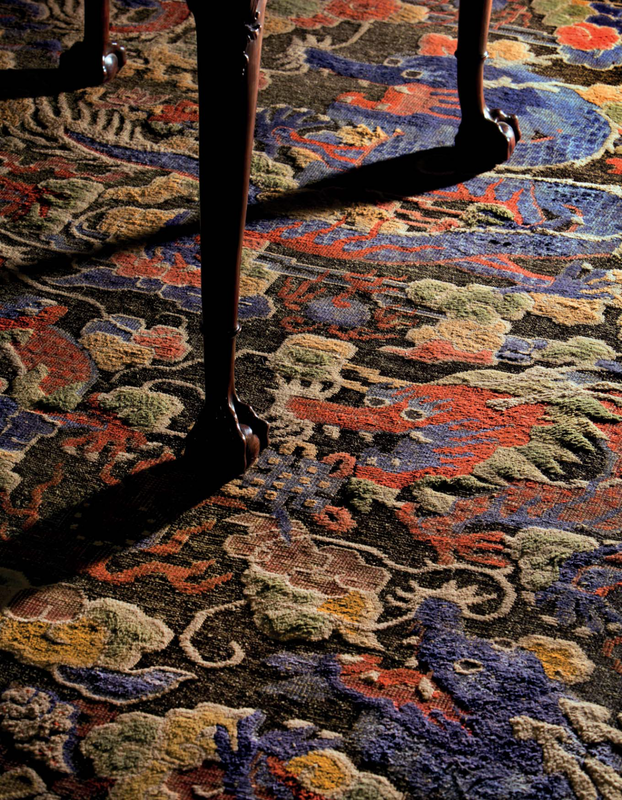A silk and metal thread 'Nine Dragon' Chinese carpet, China, Qing dynasty, late 19th century, or possibly earlier
A silk and metal thread 'Nine Dragon' Chinese carpet, China, Qing dynasty, late 19th century, or possibly earlier. Estimate $30,000 - $50,000. Price Realized $341,000 . Photo Christie's Image Ltd 2015
Woven with a three character inscription, Qianqing Gong, which translates to ‘The Palace of Heavenly Purity’. Having nine dragons chasing flaming pearls on the silver ground with a polychrome wave pattern border. Approximately 11 ft. 10 in. x 8 ft. 9 in. (361 cm. x 267 cm.)
Provenance: By repute, the Louisa McNeary Collection, New York, 1960s.
The Collection of Robert H. Ellsworth, New York.
Literature: A. Martin, “American Mandarin,” Connoisseur, November 1984, p. 95
Notes: The Qianqing Gong, or Palace of Heavenly Purity, the first of the Three Rear Halls, formerly contained the sleeping chambers of Ming emperors. During the Qing dynasty, however, emperors began to manage state affairs from the Qianqing Gong. The Palace was eventually turned into a formal living room and offices where emperors summoned subordinates for consultation, received foreign envoys, as well as gave banquets for family members, relatives and high officials (see Wan-go Weng and Yang Boda, The Palace Museum: Peking, Treasures of the Forbidden City, 1982, p. 50). It is uncertain whether or not this carpet was ever actually in the Palace but if it were, carpets inevitably would have been replaced at regular intervals.
Three similarly inscribed carpets, all of floral medallion design, were sold at Christie’s, including one sold at Christie’s Hong Kong, 30 May 2005, lot 1288, and two others sold at Christie's New York, 4 June 1992, lot 160, and 3 December 1992, lot 156. More recently, a similar silk and metal thread carpet, but with a different inscription and design, sold at Christie's London, 5 November 2008, lot 174.
Contemporary Western scholarship has traditionally placed these silk and metallic thread carpets as late 19th or early 20th century based on the dyes and weave. Most carpets woven during the late 19th century are copies of earlier carpets yet there are no known examples of Chinese silk carpets with similar designs, let alone examples with metallic thread, from the 17th century or earlier. One wonders if they did exist and are now either destroyed or not yet discovered.
Mr. Ellsworth treasured this carpet and always referred to it as a Qianlong Imperial carpet, and like some, felt this group could be earlier than current scholarship believes.
Christie's. THE COLLECTION OF ROBERT HATFIELD ELLSWORTH PART I - MASTERWORKS INCLUDING INDIAN, HIMALAYAN AND SOUTHEAST ASIAN WORKS OF ART, CHINESE AND JAPANESE WORKS OF ART, 17 March 2015, New York, Rockefeller Plaza

/https%3A%2F%2Fprofilepics.canalblog.com%2Fprofilepics%2F1%2F0%2F100183.jpg)
/https%3A%2F%2Fstorage.canalblog.com%2F03%2F02%2F119589%2F96711876_o.jpg)
/https%3A%2F%2Fstorage.canalblog.com%2F11%2F31%2F119589%2F94773502_o.jpg)
/https%3A%2F%2Fstorage.canalblog.com%2F20%2F83%2F119589%2F94772815_o.jpg)
/https%3A%2F%2Fstorage.canalblog.com%2F26%2F72%2F119589%2F75604929_o.jpg)
/https%3A%2F%2Fstorage.canalblog.com%2F59%2F60%2F119589%2F26458628_o.jpg)





/http%3A%2F%2Fstorage.canalblog.com%2F05%2F64%2F119589%2F128523518_o.jpg)
/http%3A%2F%2Fstorage.canalblog.com%2F78%2F46%2F119589%2F127133605_o.jpg)
/http%3A%2F%2Fstorage.canalblog.com%2F99%2F82%2F119589%2F126892955_o.jpg)
/http%3A%2F%2Fstorage.canalblog.com%2F51%2F84%2F119589%2F122518624_o.jpg)